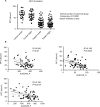The effect of pregabalin or duloxetine on arthritis pain: a clinical and mechanistic study in people with hand osteoarthritis
- PMID: 29066930
- PMCID: PMC5644551
- DOI: 10.2147/JPR.S147640
The effect of pregabalin or duloxetine on arthritis pain: a clinical and mechanistic study in people with hand osteoarthritis
Erratum in
-
Erratum: The effect of pregabalin or duloxetine on arthritis pain: a clinical and mechanistic study in people with hand osteoarthritis [Corrigendum].J Pain Res. 2017 Dec 15;10:2843. doi: 10.2147/JPR.S158537. eCollection 2017. J Pain Res. 2017. PMID: 29292797 Free PMC article.
Abstract
Osteoarthritis (OA) is the most prevalent arthritis worldwide and is characterized by chronic pain and impaired physical function. We hypothesized that heightened pain in hand OA could be reduced with duloxetine or pregabalin. In this prospective, randomized clinical study, we recruited 65 participants, aged 40-75 years, with a Numerical Rating Scale (NRS) for pain of at least 5. Participants were randomized to one of the following three groups: duloxetine, pregabalin, and placebo. The primary endpoint was the NRS pain score, and the secondary endpoints included the Australian and Canadian Hand Osteoarthritis Index (AUSCAN) pain, stiffness, and function scores and quantitative sensory testing by pain pressure algometry. After 13 weeks, compared to placebo, ANOVA found significant differences between the three groups (P=0.0078). In the intention-to-treat analysis, the pregabalin group showed improvement for NRS pain (P=0.023), AUSCAN pain (P=0.008), and AUSCAN function (P=0.009), but no difference between duloxetine and placebo (P>0.05) was observed. In the per protocol analysis, NRS pain was reduced for pregabalin (P<0.0001) and duloxetine (P=0.029) compared to placebo. We conclude that centrally acting analgesics improve pain outcomes in people with hand arthritis, offering new treatment paradigms for OA pain.
Keywords: duloxetine; hand osteoarthritis; pain; pregabalin; sensitization.
Conflict of interest statement
Disclosure The authors report no conflicts of interest in this work.
Figures






References
-
- Felson DT, Lawrence RC, Dieppe PA, et al. Osteoarthritis: new insights. Part 1: the disease and its risk factors. Ann Intern Med. 2005;13(8):635–646. - PubMed
-
- Bijlsma JW, Berenbaum F, Lafaber FP. Osteoarthritis: an update with relevance for clinical practice. Lancet. 2011;18(377):2115–2126. - PubMed
-
- NICE [webpage on the Internet] NICE Guidelines ‘Osteoarthritis: Care and Management’. 2014. [Accessed May 18, 2017]. Available from: https://www.nice.org.uk/guidance/cg177.
LinkOut - more resources
Full Text Sources
Other Literature Sources

